Xiaoping Liu
Multimodal Distillation-Driven Ensemble Learning for Long-Tailed Histopathology Whole Slide Images Analysis
Mar 02, 2025Abstract:Multiple Instance Learning (MIL) plays a significant role in computational pathology, enabling weakly supervised analysis of Whole Slide Image (WSI) datasets. The field of WSI analysis is confronted with a severe long-tailed distribution problem, which significantly impacts the performance of classifiers. Long-tailed distributions lead to class imbalance, where some classes have sparse samples while others are abundant, making it difficult for classifiers to accurately identify minority class samples. To address this issue, we propose an ensemble learning method based on MIL, which employs expert decoders with shared aggregators and consistency constraints to learn diverse distributions and reduce the impact of class imbalance on classifier performance. Moreover, we introduce a multimodal distillation framework that leverages text encoders pre-trained on pathology-text pairs to distill knowledge and guide the MIL aggregator in capturing stronger semantic features relevant to class information. To ensure flexibility, we use learnable prompts to guide the distillation process of the pre-trained text encoder, avoiding limitations imposed by specific prompts. Our method, MDE-MIL, integrates multiple expert branches focusing on specific data distributions to address long-tailed issues. Consistency control ensures generalization across classes. Multimodal distillation enhances feature extraction. Experiments on Camelyon+-LT and PANDA-LT datasets show it outperforms state-of-the-art methods.
Controlling the Latent Diffusion Model for Generative Image Shadow Removal via Residual Generation
Dec 03, 2024Abstract:Large-scale generative models have achieved remarkable advancements in various visual tasks, yet their application to shadow removal in images remains challenging. These models often generate diverse, realistic details without adequate focus on fidelity, failing to meet the crucial requirements of shadow removal, which necessitates precise preservation of image content. In contrast to prior approaches that aimed to regenerate shadow-free images from scratch, this paper utilizes diffusion models to generate and refine image residuals. This strategy fully uses the inherent detailed information within shadowed images, resulting in a more efficient and faithful reconstruction of shadow-free content. Additionally, to revent the accumulation of errors during the generation process, a crosstimestep self-enhancement training strategy is proposed. This strategy leverages the network itself to augment the training data, not only increasing the volume of data but also enabling the network to dynamically correct its generation trajectory, ensuring a more accurate and robust output. In addition, to address the loss of original details in the process of image encoding and decoding of large generative models, a content-preserved encoder-decoder structure is designed with a control mechanism and multi-scale skip connections to achieve high-fidelity shadow-free image reconstruction. Experimental results demonstrate that the proposed method can reproduce high-quality results based on a large latent diffusion prior and faithfully preserve the original contents in shadow regions.
Agent Aggregator with Mask Denoise Mechanism for Histopathology Whole Slide Image Analysis
Sep 18, 2024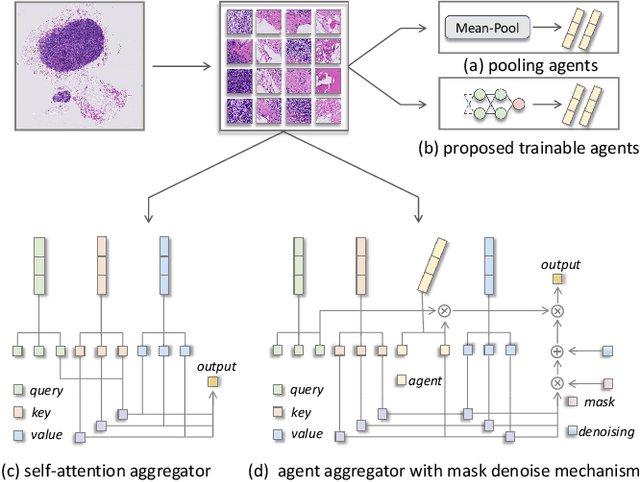
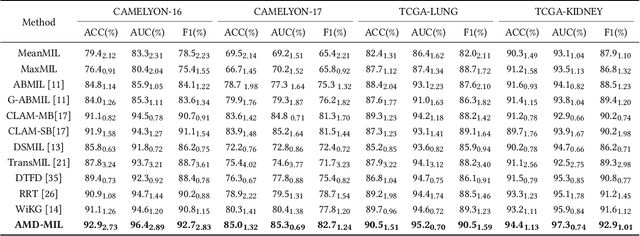
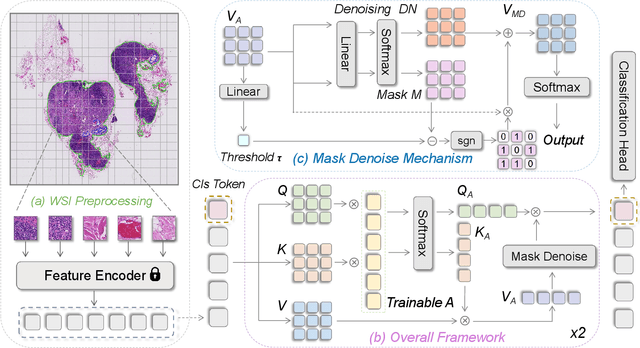
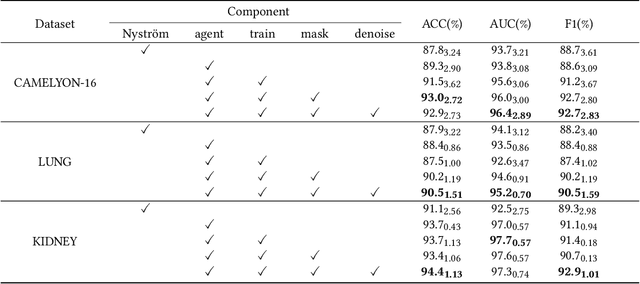
Abstract:Histopathology analysis is the gold standard for medical diagnosis. Accurate classification of whole slide images (WSIs) and region-of-interests (ROIs) localization can assist pathologists in diagnosis. The gigapixel resolution of WSI and the absence of fine-grained annotations make direct classification and analysis challenging. In weakly supervised learning, multiple instance learning (MIL) presents a promising approach for WSI classification. The prevailing strategy is to use attention mechanisms to measure instance importance for classification. However, attention mechanisms fail to capture inter-instance information, and self-attention causes quadratic computational complexity. To address these challenges, we propose AMD-MIL, an agent aggregator with a mask denoise mechanism. The agent token acts as an intermediate variable between the query and key for computing instance importance. Mask and denoising matrices, mapped from agents-aggregated value, dynamically mask low-contribution representations and eliminate noise. AMD-MIL achieves better attention allocation by adjusting feature representations, capturing micro-metastases in cancer, and improving interpretability. Extensive experiments on CAMELYON-16, CAMELYON-17, TCGA-KIDNEY, and TCGA-LUNG show AMD-MIL's superiority over state-of-the-art methods.
Multi-frame Joint Enhancement for Early Interlaced Videos
Sep 29, 2021



Abstract:Early interlaced videos usually contain multiple and interlacing and complex compression artifacts, which significantly reduce the visual quality. Although the high-definition reconstruction technology for early videos has made great progress in recent years, related research on deinterlacing is still lacking. Traditional methods mainly focus on simple interlacing mechanism, and cannot deal with the complex artifacts in real-world early videos. Recent interlaced video reconstruction deep deinterlacing models only focus on single frame, while neglecting important temporal information. Therefore, this paper proposes a multiframe deinterlacing network joint enhancement network for early interlaced videos that consists of three modules, i.e., spatial vertical interpolation module, temporal alignment and fusion module, and final refinement module. The proposed method can effectively remove the complex artifacts in early videos by using temporal redundancy of multi-fields. Experimental results demonstrate that the proposed method can recover high quality results for both synthetic dataset and real-world early interlaced videos.
Improving Global Forest Mapping by Semi-automatic Sample Labeling with Deep Learning on Google Earth Images
Aug 06, 2021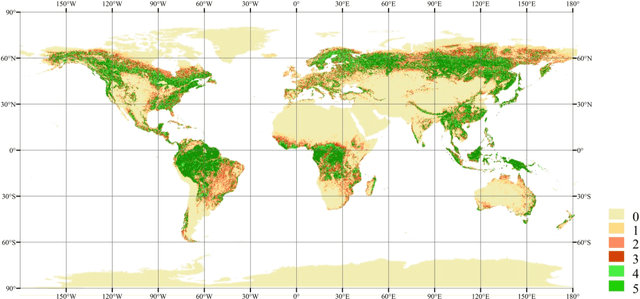
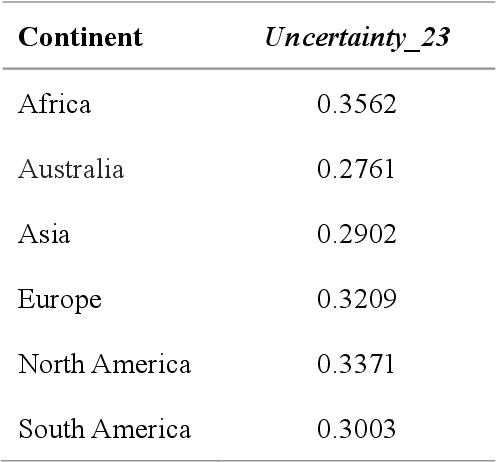
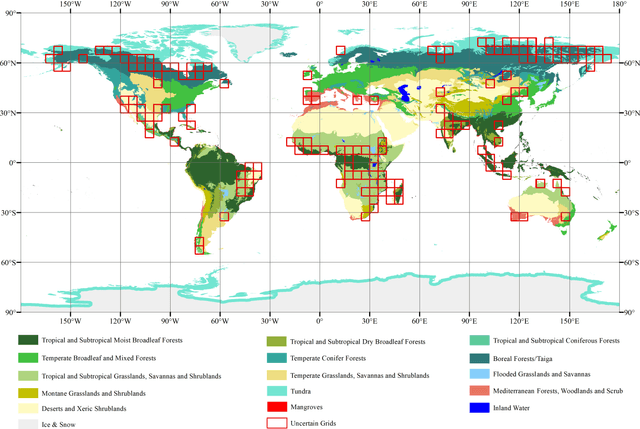
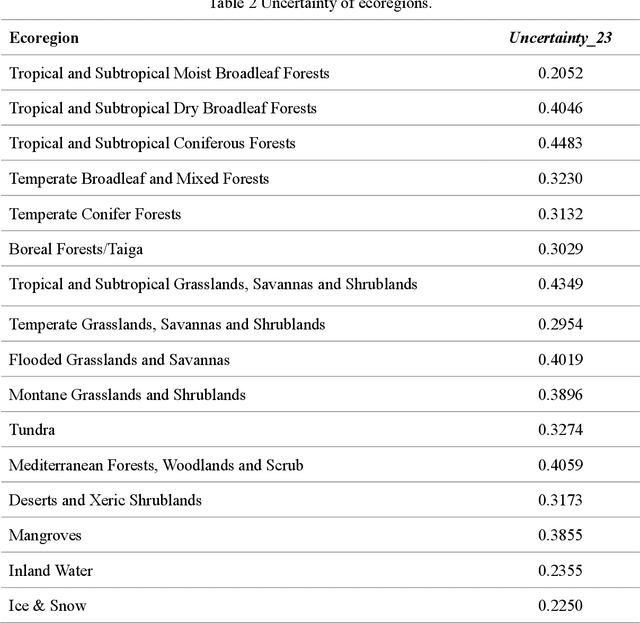
Abstract:Global forest cover is critical to the provision of certain ecosystem services. With the advent of the google earth engine cloud platform, fine resolution global land cover mapping task could be accomplished in a matter of days instead of years. The amount of global forest cover (GFC) products has been steadily increasing in the last decades. However, it's hard for users to select suitable one due to great differences between these products, and the accuracy of these GFC products has not been verified on global scale. To provide guidelines for users and producers, it is urgent to produce a validation sample set at the global level. However, this labeling task is time and labor consuming, which has been the main obstacle to the progress of global land cover mapping. In this research, a labor-efficient semi-automatic framework is introduced to build a biggest ever Forest Sample Set (FSS) contained 395280 scattered samples categorized as forest, shrubland, grassland, impervious surface, etc. On the other hand, to provide guidelines for the users, we comprehensively validated the local and global mapping accuracy of all existing 30m GFC products, and analyzed and mapped the agreement of them. Moreover, to provide guidelines for the producers, optimal sampling strategy was proposed to improve the global forest classification. Furthermore, a new global forest cover named GlobeForest2020 has been generated, which proved to improve the previous highest state-of-the-art accuracies (obtained by Gong et al., 2017) by 2.77% in uncertain grids and by 1.11% in certain grids.
Super-resolution-based Change Detection Network with Stacked Attention Module for Images with Different Resolutions
Feb 27, 2021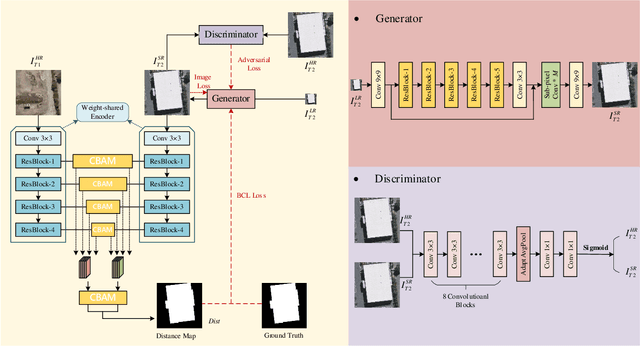
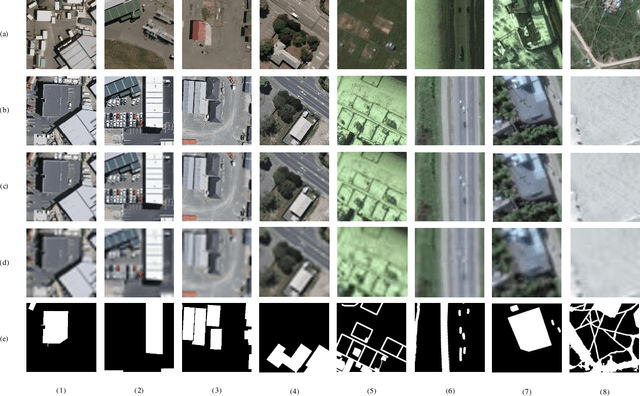
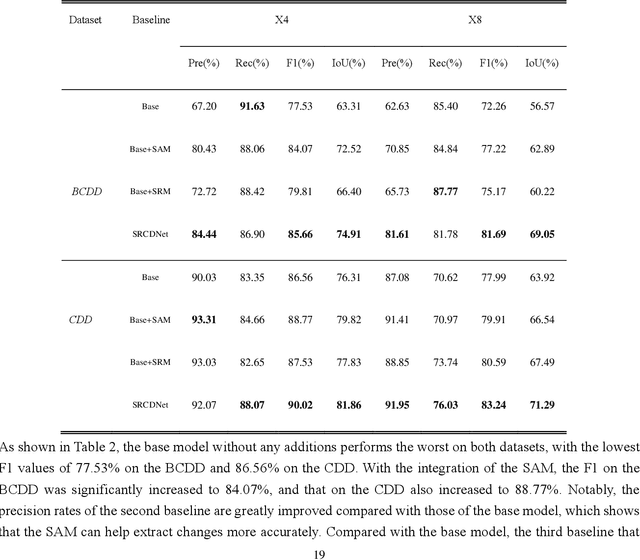

Abstract:Change detection, which aims to distinguish surface changes based on bi-temporal images, plays a vital role in ecological protection and urban planning. Since high resolution (HR) images cannot be typically acquired continuously over time, bi-temporal images with different resolutions are often adopted for change detection in practical applications. Traditional subpixel-based methods for change detection using images with different resolutions may lead to substantial error accumulation when HR images are employed; this is because of intraclass heterogeneity and interclass similarity. Therefore, it is necessary to develop a novel method for change detection using images with different resolutions, that is more suitable for HR images. To this end, we propose a super-resolution-based change detection network (SRCDNet) with a stacked attention module. The SRCDNet employs a super resolution (SR) module containing a generator and a discriminator to directly learn SR images through adversarial learning and overcome the resolution difference between bi-temporal images. To enhance the useful information in multi-scale features, a stacked attention module consisting of five convolutional block attention modules (CBAMs) is integrated to the feature extractor. The final change map is obtained through a metric learning-based change decision module, wherein a distance map between bi-temporal features is calculated. The experimental results demonstrate the superiority of the proposed method, which not only outperforms all baselines -with the highest F1 scores of 87.40% on the building change detection dataset and 92.94% on the change detection dataset -but also obtains the best accuracies on experiments performed with images having a 4x and 8x resolution difference. The source code of SRCDNet will be available at https://github.com/liumency/SRCDNet.
Deinterlacing Network for Early Interlaced Videos
Nov 27, 2020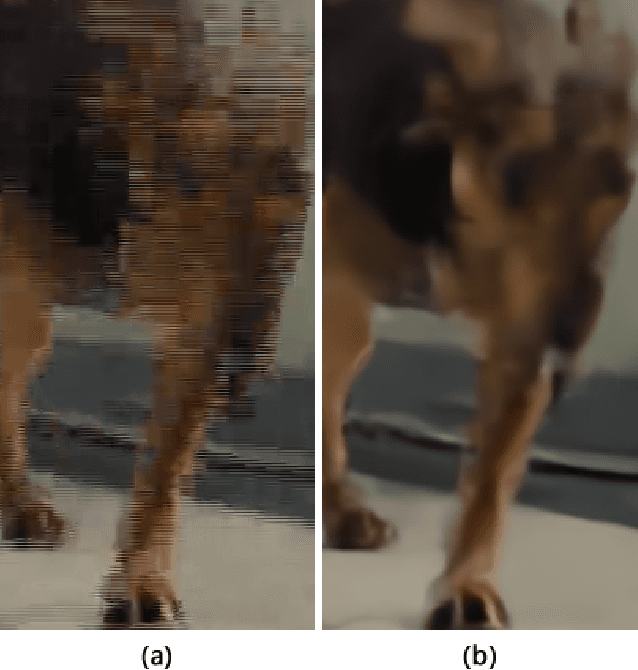
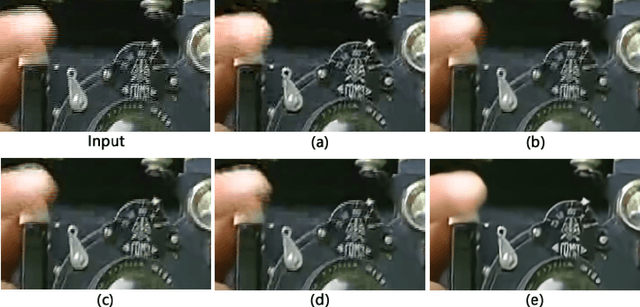
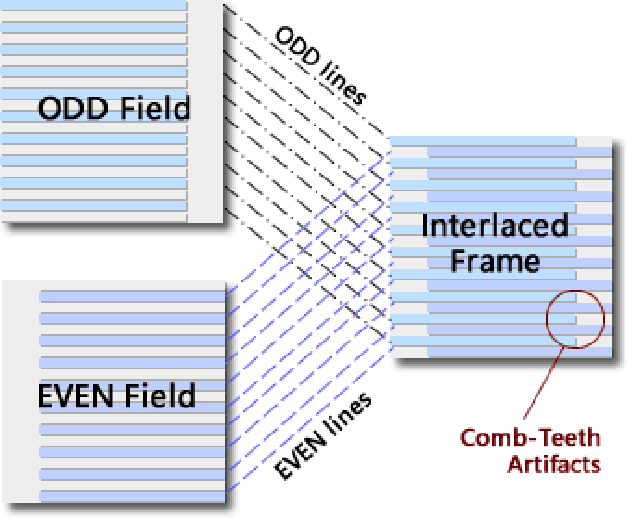
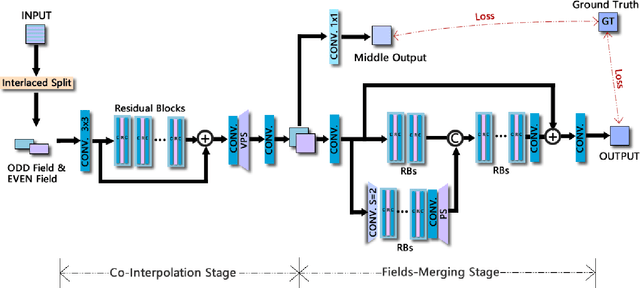
Abstract:With the rapid development of image restoration techniques, high-definition reconstruction of early videos has achieved impressive results. However, there are few studies about the interlacing artifacts that often appear in early videos and significantly affect visual perception. Traditional deinterlacing approaches are mainly focused on early interlacing scanning systems and thus cannot handle the complex and complicated artifacts in real-world early interlaced videos. Hence, this paper proposes a specific deinterlacing network (DIN), which is motivated by the traditional deinterlacing strategy. The proposed DIN consists of two stages, i.e., a cooperative vertical interpolation stage for split fields, and a merging stage that is applied to perceive movements and remove ghost artifacts. Experimental results demonstrate that the proposed method can effectively remove complex artifacts in early interlaced videos.
GUN: Gradual Upsampling Network for Single Image Super-Resolution
Jul 04, 2018
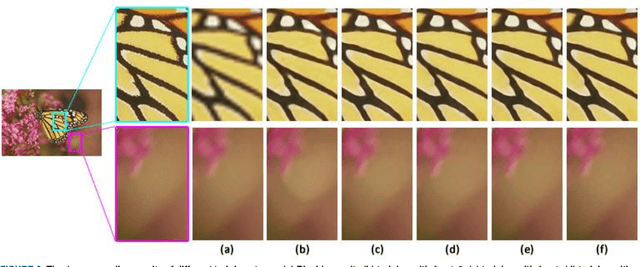


Abstract:In this paper, an efficient super-resolution (SR) method based on deep convolutional neural network (CNN) is proposed, namely Gradual Upsampling Network (GUN). Recent CNN based SR methods often preliminarily magnify the low resolution (LR) input to high resolution (HR) and then reconstruct the HR input, or directly reconstruct the LR input and then recover the HR result at the last layer. The proposed GUN utilizes a gradual process instead of these two commonly used frameworks. The GUN consists of an input layer, multiple upsampling and convolutional layers, and an output layer. By means of the gradual process, the proposed network can simplify the direct SR problem to multistep easier upsampling tasks with very small magnification factor in each step. Furthermore, a gradual training strategy is presented for the GUN. In the proposed training process, an initial network can be easily trained with edge-like samples, and then the weights are gradually tuned with more complex samples. The GUN can recover fine and vivid results, and is easy to be trained. The experimental results on several image sets demonstrate the effectiveness of the proposed network.
 Add to Chrome
Add to Chrome Add to Firefox
Add to Firefox Add to Edge
Add to Edge